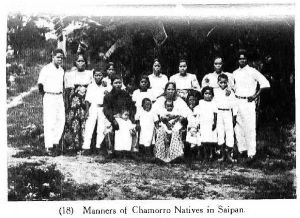(Photo Source: Annual Report to the League of Nations on the Administration
of the South Sea Islands Under Japanese Mandate for the Year 1924)
The recent genealogy update of Tan Nicolasa Lujan Asang has pulled my research interests in so many directions. Can you say vertigo? Lol. I’m trying to narrow it down in slices to try get a better historical understanding of why or how some CHamoru people were sent mostly to Yap and Palau. From there, some returned and some moved on to different locations in Papua New Guinea (PNG). Some stayed in PNG and while others left for Australia.
As I sift through historical documents or literature referencing some of the name places it has added to my learning frustrations. For instance, in some cases the term Micronesian would be broadly used and there are no specifics as to which ethnic group or person was tied to the event. Same as when the term Caroline Islands is used, a reader is not able to ascertain a specific island of reference.
Initially, I generalized my statement that many of these CHamoru people were used for farming. However, another primary reason why some CHamoru people were recruited for work in Anguar, Palau was for phosphate ore mining, beginning with the German administration in 1909. Some literature suggests that the reason why CHamoru people were sought after by the German (1899 - purchased most of Micronesia, except Guam from Spain) and Japanese (1914 – seized Japan from Germans and later given a League of Nations Mandate) administrations for labor was because, the CHamoru people had already been exposed, accustomed, and understood the “money economy,” system after being colonized and assimilated from the 200 plus years of Spanish occupation.
I am learning the term “indentured labor or servant,” which refers to some type of contract between the employee and employer. In some cases, there may be coercion, coaxing or free will towards engaging in the labor arrangement. Some may have been in debt or assumed the debt of another family member and the only way to repay that debt was through the contract.
I must admit though another one my naiveties. Before, I only thought that it was the CHamoro people under the German and Japanese administration that left to other islands and PNG for farming. However, there were CHamoru people from Guam that left too. I was remissed, because even though the Spanish-American War resulted in the partition of the Mariana Islands (Guam being separated from the rest of the Northern Mariana Islands), the CHamoru people remain one ethnic group and equally important have the same genealogical ties. Therefore, during the U.S., German and Japanese occupations, CHamoru families were still keeping in contact and visiting each other across the islands until the beginning of World War II.
The impact of the League of Nations Mandate and World War II seems to have deeply divided the CHamoru people. In fact, some of the trauma and hate caused by a few CHamoru people under the Japanese occupation during World War II, sadly exists to this very day. But that’s another story in itself.
Through some of the annual reports by the Japanese government, I have extracted some CHamoru population data under their administration. It is interesting to note that the Japanese government, within the “Micronesian stock,” labeled the CHamoru people as “Chamorro,” while all other ethnic Micronesian groups were referred to as “Kanaka.”
CHamoru Population Under Japan Administration
|
District |
1924[1] |
1925[2] |
1930[3] |
1931[4] |
|
Saipan |
2526 |
2577 |
2846 |
3040 |
|
Palau |
168 |
222 |
215 |
206 |
|
Yap |
160 |
151 |
157 |
159 |
|
Truk |
0 |
2 |
9 |
7 |
|
Ponape |
0 |
0 |
74 |
60 |
|
Total |
2854 |
2952 |
3301 |
3472 |
*The population for Saipan (district) includes all of the Northern Mariana Islands (not Guam).
CHamoru Workers at the Mining Station, Palau
|
Mining in Palau |
1924 |
1925 |
1930 |
1931 |
|
Male |
25 |
25 |
25 |
27 |
|
Female |
1 |
1 |
0 |
0 |
*The woman was an office worker for the mining station.
Because I have the 1920 and 1930 Census transcription data for Guam, I have the data of those born in other places of Micronesia that may later serve as another slice for a research project.
1920 US Census - Guam[5]
- 10 people were recorded with a birthplace of either Caroline Islands, Yap, Yap Island, Yap, Car Is.
- Surnames: Blas (6), Camacho (1), Alufaq (1) and Tejada (2)
1930 US Census - Guam[6]
- Five (5) people were recorded with a birthplace of Caroline Islands
- Surnames: Leon Guerrero (1), Aldan (1), Sacramento (1), Aflague (1), Aguon (1)
Footnotes:
[1] Japanese Government. 1925. Annual Report to the League of Nations on the Administration of the South Sea Islands Under Japanese Mandate for the Year 1924. Geneva
[2] Japanese Government. 1926. Annual Report to the League of Nations on the Administration of the South Sea Islands Under Japanese Mandate for the Year 1925. Geneva
[3] Japanese Government. 1931. Annual Report to the League of Nations on the Administration of the South Sea Islands Under Japanese Mandate for the Year 1930. Geneva
[4] Japanese Government. 1932. Annual Report to the League of Nations on the Administration of the South Sea Islands Under Japanese Mandate for the Year 1931. Geneva
[5] Bernard Punzalan. 2021. CHamoru Roots Genealogy Project. http://www.chamorroroots.com
[6] Ibid.


